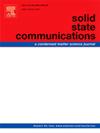Changes in crystal structure and resistivity of deformed germanium by high-pressure torsion
IF 2.1
4区 物理与天体物理
Q3 PHYSICS, CONDENSED MATTER
引用次数: 0
Abstract
Single-crystal Ge(100) disks were deformed by high-pressure torsion (HPT). The sample after HPT processed at a nominal pressure of 6 GPa without anvil rotation (N = 0) consisted of diamond-cubic Ge-I, while metastable Ge-III appeared after rotating the anvils and following pressure release. The volume fraction of Ge-III increased as the number of anvil rotations (N) increased. The crystallite sizes of Ge-I and Ge-III decreased to ∼10 nm for N ≥ 50. The Ge-III phase disappeared and only Ge-I existed after annealing at 573 K. The resistivity of Ge samples decreased from 64 Ω cm to 3.5 Ω cm after compression (N = 0). The resistivity increased to ∼107 Ω cm when increasing N to 100. The decrease in resistivity for N = 0 indicated the introduction of carriers generated by lattice defects. The increase in resistivity with increasing N was due to the refinement of grains as well as to the formation of semiconducting Ge-III. No significant change in resistivity was observed after annealing. These resistivity changes observed in HPT-processed Ge were found to be different from those observed in HPT-processed Si.
求助全文
约1分钟内获得全文
求助全文
来源期刊

Solid State Communications
物理-物理:凝聚态物理
CiteScore
3.40
自引率
4.80%
发文量
287
审稿时长
51 days
期刊介绍:
Solid State Communications is an international medium for the publication of short communications and original research articles on significant developments in condensed matter science, giving scientists immediate access to important, recently completed work. The journal publishes original experimental and theoretical research on the physical and chemical properties of solids and other condensed systems and also on their preparation. The submission of manuscripts reporting research on the basic physics of materials science and devices, as well as of state-of-the-art microstructures and nanostructures, is encouraged.
A coherent quantitative treatment emphasizing new physics is expected rather than a simple accumulation of experimental data. Consistent with these aims, the short communications should be kept concise and short, usually not longer than six printed pages. The number of figures and tables should also be kept to a minimum. Solid State Communications now also welcomes original research articles without length restrictions.
The Fast-Track section of Solid State Communications is the venue for very rapid publication of short communications on significant developments in condensed matter science. The goal is to offer the broad condensed matter community quick and immediate access to publish recently completed papers in research areas that are rapidly evolving and in which there are developments with great potential impact.
 求助内容:
求助内容: 应助结果提醒方式:
应助结果提醒方式:


